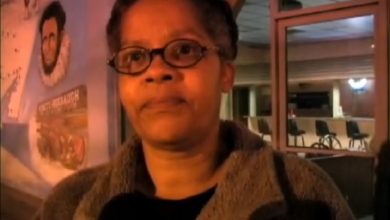Returning South Carolina’s Atlantic Beach to its ‘Black Pearl’ status

From an aerial view, Atlantic Beach is a 92-acre cutout in North Myrtle Beach, an interruption in the coastline. The town spans just four blocks, comprising mostly of beach homes and small family-owned motels. But for more than three decades, this small tract of land was a bustling vacation destination for hundreds of Black travelers and one of the few places where Black people could experience the ocean in a segregated South. It was known as “The Black Pearl.”
Those who remember the height of Atlantic Beach say the community has become a ghost town after years of decline. For decades, residents, city officials and property owners have debated on the best ways to preserve the town’s history while also reinvigorating tourism and returning the town to the shining pearl it once was.
Atlantic Beach began in 1934, when George Tyson, a Black business owner from Wilmington, N.C., purchased 47 acres of beachfront property. A few years later, he purchased an additional tract of land, located on the west side of the highway and adjacent to the initial tract.
Tyson wanted to create an oasis for Black travelers. In the Jim Crow era of the late 19th and early 20th centuries, beaches — like many public places — were segregated by race. A sprinkling of Black resort towns would sprout up during this time, including Highland Beach in Maryland and American Beach on Florida’s Amelia Island.
“This guy had a vision so far ahead of time,” said Patricia Mallett, 68, who visited Atlantic Beach in the 1960s and became a resident in the 1980s. “[Tyson] put it in the deed at that time, that there will be nothing but houses built on the oceanfront. It’s miraculous, because even today we can enjoy the view all the way from Highway 17 down to the ocean. You can’t do that on many streets here in the Grand Strand area.”
Tyson eventually sold Atlantic Beach, more than 90 acres of prime beachfront land, to the newly formed Atlantic Beach Company, a group of Black educators, doctors, lawyers and morticians dedicated to developing the land for other Black Americans.
Atlantic Beach was surrounded by White beach towns that enforced segregation by putting up orange rope and fences along the beach, making this small area a safe haven for Black Americans. Between the Civil War and World War II, South Carolina was one of the 12 most active lynching states in America, according to the Equal Justice Initiative.
“I remember that maids, cooks and butlers could go to the White beaches if they worked for White families,” Mallett said. “But still, my own experience was just joyful. It didn’t matter, because we had our own space.”
The Grand Strand area experienced rapid growth during the 1940s and 1950s, as paved roads made the area more accessible to tourists. Atlantic Beach was no exception, and as word of this Black-owned beachfront spread, more people purchased lots and opened hotels, night clubs, restaurants and novelty shops.
The earliest lodgings — Smith’s Place, Hotel Marshall and Hotel Gordon — are remembered as being grandiose structures, with dining parlors, ice cream stands and swimsuit rentals.
Tyson kept a few plots of land for himself, one for the Black Hawk Night Club, where performers such as James Brown, Fats Domino and Marvin Gaye would grace the stage for an encore after performing in all-White towns earlier in the night.
The streets were lined with roadside souvenir photo stands, where families and couples could take pictures in front of beach-themed scenes with signs that read “Atlantic Beach,” “Hey baby” and “Just for you.”
Travelers by the busloads
By 1960, only a handful of families lived in Atlantic Beach year-round, attending First Missionary Baptist Church, riding horses down South Ocean Boulevard, fishing on the beach and frequenting the Silver Platter, a fish fry restaurant owned by Mary Harley Glass Williams.
“As a child, you came to Atlantic Beach and you were just free to roam. I remember hamburger stands, a Ferris wheel and dance floors we used to call patios. People would dance all day and all night on weekends,” Mallett said.
Jake Evans’s parents, who lived in New Jersey at the time, purchased a lot in the early 1960s and opened the Evans Motel. Evans, now Atlantic Beach’s mayor, recalls looking forward to summers as a kid.
“Back during those days, it was very crowded,” said Evans, who compared Atlantic Beach in the late ’60s with the crowds found on North Myrtle Beach today. “Every Friday afternoon, we would start seeing people coming in by the busloads. Being born in New Jersey and coming back and forth, I just couldn’t wait till the summer came, because I got to see the ocean and to enjoy this fun place.”
After the summer of 1967, the Evanses decided to make Atlantic Beach their year-round home, when Jake was 10 years old. The following year, just a few years after the Civil Rights Act of 1964 outlawed segregation, the surrounding beaches — Cherry Grove Beach, Crescent Beach, Ocean Drive Beach and Windy Hill Beach — joined under the umbrella of North Myrtle Beach.
Atlantic Beach declined their invitation, instead incorporating as its own fully independent municipality. But with segregation no longer the law, Black travelers started venturing out to previously White-only vacation destinations. Slowly, the crowds at Atlantic Beach began decreasing in size, even during the summer. Business declined, while the newly formed North Myrtle Beach boomed with high-rises and tourism.
“After segregation, everybody wanted to go to other places to see what was going on,” Mallett said. “So economically, yes, the town went down.”
Still, the small enclave of Atlantic Beach weathered on. Emery Gore became the first mayor, and a town hall was constructed, followed by a fire department and community center. Jake’s mother, Earlene Evans Woods, became one of the first councilwomen of Atlantic Beach, and he and his siblings have followed suit.
Jake now lives in the original Evans Motel, once operated by his parents.
“I want to see it flourish again like it did in the ’60s. A lot of Black beaches over the years didn’t survive, and the fact that we are still here is just humongous to me.”
In the 1980s, the town started Black Bike Week, an annual festival for Black motorcyclists, to reinvigorate tourism. Although the event brings in thousands of visitors, the tourism has yet to spill over into other parts of the year. Last year, during the 42nd bike fest, Benjamin Quattlebaum, the town manager, said Atlantic Beach made about $85,000 from the festival, but operational expenses totaled nearly $50,000. The event has also been linked to several shootings in the area, and residents in neighboring North Myrtle Beach have complained about the noise and crowds.
Despite efforts to bring the crowds back to Atlantic Beach, the town remains one of the smallest and poorest municipalities in the state.
Mallett likens Atlantic Beach’s fate with a 1960s song called “Black Pearl,” by Sonny Charles and the Checkmates.
“The song says: ‘Black pearl, precious little girl, let me put you up where you belong. You’ve been in the background [much] too long,’” Mallett said. “That is Atlantic Beach. This place is our Black pearl, and we’ve been put in the background and forgotten.”
Revitalizing a ‘Black Pearl’
While visiting North Myrtle Beach in 2000, Sherry Suttles had a thought.
“I sat there on the beach, looked around and said, ‘I don’t see no Black people at this beach! I wonder where the Black people go,’” Suttles said. “That next day, I went to the Chamber of Commerce, and I said, ‘Where are all the Black people at this beautiful tourist beach?’ They sent me to Atlantic Beach.”
What Suttles found was not the packed Atlantic Beach of the mid-to-late 20th century. Fewer than 400 people lived in the town at that time, and there were only a handful of vacation rentals left. Several opportunities for development came and went between 1984 and 2000; developers had trouble persuading enough landowners to do the same things with their property or getting the town council to approve projects.
And, although racial segregation was a thing of the past, South Ocean Boulevard and First Avenue still didn’t connect. Chain-link fences separated the Bay Watch Resort of North Myrtle Beach from the decades-old Holiday Motel & Restaurant on Atlantic Beach.
Still, the ghost town caught Suttles’s interest.
Suttles wasn’t just a beach lover. She was also the first Black female city manager in the nation in Oberlin, Ohio, in 1979, a job that launched a long career in public administration. The more Suttles learned about the history of Atlantic Beach, the more she wanted to bring attention to the town’s history.
In 2001, Suttles founded the Atlantic Beach Historical Society to act as the town’s historical preservation and cultural committee. The group coordinated a historical photography exhibit, a parade and other events that brought a modicum of attention and tourist traffic to Atlantic Beach.
In 2004, a grant from the South Carolina Humanities funded an oral history project. ABHS recorded interviews with Atlantic Beach residents and visitors who remembered the crowded summers of the town’s past.
“I recall that longtime resident Rosa Stanley helped me identify the major families who should be involved in the project,” Suttles said. “I was thrown back into the past, listening to these people remembering their parents, the stores and restaurants. There was a lot of sadness, too, because now that’s all gone, and they felt they couldn’t turn it around.”
Suttles was also elected to the Atlantic Beach Town Council and says she witnessed firsthand the tension that came with the pressure to increase tourism.
“There’s a disconnect between the property owners and the people who actually live in Atlantic Beach,” she explained. “Residents want their view of the beach and are against high-rise developments on the oceanfront. As a beachgoer, I don’t like the idea of a tower blocking that sun either, but as a city and county administrator, … I know the value of it to the community.”
Eventually, Suttles and ABHS would erect an Atlantic Beach historical marker in front of the town hall, as well as publish a book of historical photos that detail the creation of the town. ABHS disbanded in 2007, feeling as if it had done all it could to capture the story of Atlantic Beach. Suttles moved on to Florida.
In the years since, Black Bike Week has continued, and locals have started additional events aimed at bringing travelers back to Atlantic Beach.
Mallett helped lead the town’s recent partnership with the federal Gullah Geechee Cultural Heritage Corridor Commission to create the Gullah Geechee Culture and Nature Festival, with lectures, dance performances, food and exhibitions.
In February, developer Charles Morant presented an idea for an $80 million to $100 million high-rise development on 30th Avenue South. The town council recently approved an ordinance to allow the project to move forward.
Mallett, who is against the idea of a high-rise on Atlantic Beach’s oceanfront, says she believes there are other ways to bring in monetary gains.
“I can look from my porch and see the ocean — and I’m a block away,” Mallett says. “I would love to have businesses come in designated areas, like Main Street, but let us enjoy that view as far as we can see. Our forefathers have already planned out this for us. Let’s just try to follow that, because it’s sustained us so far.”
In 2022, Atlantic Beach was listed in the National Park Service’s study on how race affected African Americans’ experiences and access to outdoor recreation between 1865 and the early 21st century. NPS found that further study is needed to determine the integrity of the town and its buildings before Atlantic Beach could be listed as a National Historic Landmark.
“There’s this dream that [Atlantic Beach] will come back and be the little town it always was, but it’s hard to compete with North Myrtle Beach and all those hotels,” she said. “I love Atlantic Beach, and I love the people there. I love the possibilities of it.”
Ariel Felton is a writer based in Savannah, Ga. You can follow her on Twitter: @Ariel_R_Felton.
























































